Gone are the days when only keyboard players could have fun with synths. Us woodwind players also want a bit of the action! Electronic wind instruments give us just that.
Now there’s a whole range of different electronic wind instruments, or EWIs as they are affectionately called, but how do they differ and which one is right for you? Let’s discuss a few of the different EWIs currently on the market and help you choose the right one for you.
Yamaha YDS 150
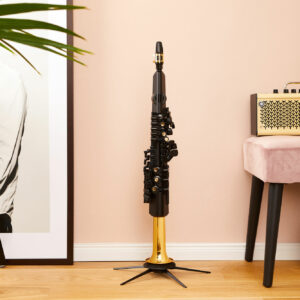 The Yamaha YDS 150 Digital Wind Synthesiser has been around for a year now and it’s a popular electronic wind instrument amongst our customers.
The Yamaha YDS 150 Digital Wind Synthesiser has been around for a year now and it’s a popular electronic wind instrument amongst our customers.
Visually, it’s very much like a soprano saxophone. In fact, it’s modelled on one of Yamaha’s premium sopranos and the brass bell on the end – a particularly nice feature – is taken from their trumpets. This is designed to give some weight to the instrument, and it looks pretty cool, in my opinion. So, if you need a stand, look for a trumpet stand!
As the EWI looks like a saxophone, it will instantly feel more comfortable to a sax player. The mouthpiece, although designed for the YDS, is an alto sax mouthpiece – and you can even add your own, along with your reed, if you want that familiarity.
Built into the YDS is a whole host of different sounds, including a vast range of saxophone voices which can all be controlled via the accompanying app (this is exceptionally easy). You can choose a variety of different saxophones from soprano down to baritone and a few different versions of them too, to suit the style of playing.
The additional technology around the YDS is also where this electronic wind instrument really comes into its own. With the accompanying app, YDS Controller, you can get into the nitty-gritty of the sounds and other settings. The app also allows you to add custom fingerings, so you can programme your favourite altissimo fingerings (at least they’ll be reliable rather than clenching and hoping for the best!).
Better still, the YDS has Bluetooth capabilities, meaning you can stream music into the YDS (but unfortunately not out from it) and play along to your favourite tracks.
Team this with the 3-month premium subscription to TomPlay, and you’ll have some great fun. I’ve tried the YDS with our wireless bundle and played through an amp along to Baker Street! I could easily lose a lot of my time doing this!
Shop now | Yamaha YDS 150 Digital Wind Synthesiser
Shop now | Yamaha YDS 150 Digital Wind Synthesiser Wireless Pack
re.corder
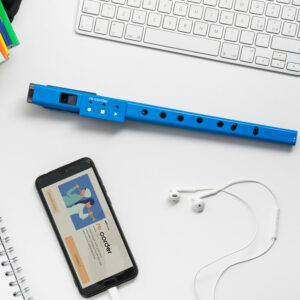 Everyone, no doubt, will have learned recorder when they were young. I certainly have fond memories of learning Eastenders and Match of the Day at primary school! The re.corder brings another dimension to this traditional instrument.
Everyone, no doubt, will have learned recorder when they were young. I certainly have fond memories of learning Eastenders and Match of the Day at primary school! The re.corder brings another dimension to this traditional instrument.
Often the first route into music for a lot of people, the recorder is commonly used as an educational tool. So, the guys at Artinoise have taken this one step further. Their innovative re.corder not only feels familiar, but it can also be used as a wind synth. Plus, there’s a wide range of features to help you learn.
This is the most budget-friendly option and it also doubles as an acoustic recorder. Simply remove the plastic mute plug out of the window and it operates as you would expect.
Recorders, believe it or not, come in two different formats: Baroque and German. The Baroque system is possibly more difficult to learn the fingerings of but it has precise tuning whereas the German system is easier fingering-wise but less reliable on the tuning.
Acoustically, this is a Baroque-style recorder. Through the accompanying app, however, you can dive into the digital side and set the fingering patterns yourself, with a whole range of different settings available. This is particularly helpful if you’re used to other instruments or unable to play in the traditional way.
Some other cool settings you can amend are the different play modes. Breath mode, as you might expect, is the more usual way of playing – you blow through the re.corder to get the sound. The Lip Sensor mode, on the other hand, simply requires you to put the instrument against your lips (or against anything else really) to generate the sound. Keyboard mode then lets you tap or hold over any hole (or key) and it will create the sound. This is great if you want to use it as a drum pad.
Also on the app, which is regularly updated, are modes where you can learn music, such as Hot Cross Buns (sorry if that’s triggered some early recorder memories!). This mode grades your performance before moving onto the next ‘level’. You can also play some favourite tunes or jam along with friends by connecting multiple re.corders to the same app.
It’s a great educational tool as an introduction to electronic wind instruments.
Shop now | re.corder
Roland AE Aerophones
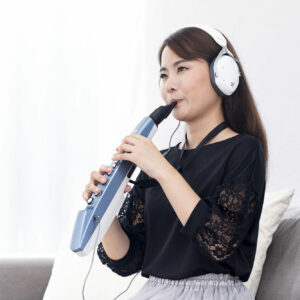 Roland have always been at the forefront of synths and so it’s great to see a range of wind synths, the AE Aerophones, from them on the market. They all have their own differences which suit players in a variety of ways.
Roland have always been at the forefront of synths and so it’s great to see a range of wind synths, the AE Aerophones, from them on the market. They all have their own differences which suit players in a variety of ways.
The first of the Roland Aerophones to be released was the AE10 five years ago, and this was my first real introduction to a wind synth.
In a lot of ways, the design is fairly minimal but functional. All the keys are where you’d expect them to be – with a simplified construction as they’re essentially buttons which have no need for the mechanisms.
Similarly, the AE05 is a slimmed-down version of the AE10 with a smaller footprint. It’s a simpler model in a lot of ways with dials to select sounds rather than scrolling through options on a screen. So if you’re after a simple introduction to Roland Aerophones, this might be the model for you.
Also, as it’s so compact, it’s ideal for taking on the road and using as a practice tool, allowing you to easily rehearse in a hotel room with a set of headphones.
The Aerophone Mini – or AE01 – is even more slimmed down in a number of ways. There aren’t the play keys or table keys that you’d expect on a saxophone, but there are six in-built sounds (more are accessible through the app). In terms of aesthetics, it looks similar to some other models of EWI on the market.
Thanks to Bluetooth capabilities, you can stream the MIDI through to your computer and Digital Audio Workstation (DAW) of your choice. The six in-built sounds can easily be added to – it’s the perfect way to get your creative juices flowing!
More recently, the range has seen the introduction of the AE20 and AE30, complete with SuperNATURAL and ZEN-Core sound engines. They seriously pack a punch.
With the AE20, you have a whopping 250 voices under your fingers, including acoustic and electronic sounds and ethnic instruments such as the Japanese shakuhachi or bagpipes.
The ZEN-Core Sound Synthesis System is the same technology that’s used in their flagship keyboard synths. And all the voices can be manipulated with your breath. Plugging into an amp or PA would be ideal for this EWI with the wide range of sounds at your disposal – you don’t necessarily need to plug into a DAW to access more sounds.
The AE30 benefits from even more sounds. All features have been developed in collaboration with expert wind players, using their feedback to really make it the ultimate wind synth. Similar to the Yamaha app, you can use Roland Cloud and the Aerophone Pro Editor to control every parameter and refine your sound even further.
Shop now | Roland AE Aerophones
Akai EWIs
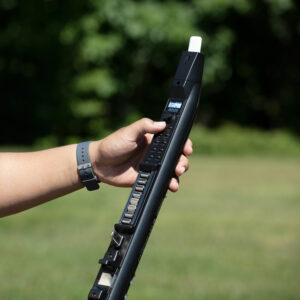 Akai have been manufacturing EWIs for years. It’s the product that immediately comes to mind when I think of the term ‘EWI’ (plus, theirs are called EWIs too). Their models have continually improved over the years and their latest release is the EWI Solo.
Akai have been manufacturing EWIs for years. It’s the product that immediately comes to mind when I think of the term ‘EWI’ (plus, theirs are called EWIs too). Their models have continually improved over the years and their latest release is the EWI Solo.
One of the nice additions to previous EWI models is the speaker at the bottom. This also makes it look more reminiscent of a clarinet – a long, black instrument, with a bell at the bottom and silver keys. However, it’s much more modern looking.
The ‘keys’ on the EWI Solo are more touch points rather than keys or buttons, so they do take a bit of getting used to. More interesting additions come in the form of rollers on the back. These allow you to play over an impressive seven octaves, right from deep bass notes to piercing trebles!
After years of development and design, the user interface is pretty straightforward. It boasts an adjustment knob to change settings and sounds as well as a touchpad on the back for controlling pitch-bends.
Double the amount of sounds has been packed into the EWI Solo compared to the EWI 5000. Contained within the 200 tones are a wide selection of synths, woodwind instruments, brass instruments, and loads of ethnic instruments and lead pads too.
Shop now | Akai EWIs
Which EWI is right for me?
All these electronic wind instruments have features that will appeal to a range of players.
As an entry to EWIs, the re.corder might be the way to go as it builds on the familiarity of a recorder and can help develop your skills from an educational perspective. It enables you to start exploring the fundamentals of EWIs, such as breath pressure etc.
If you’re looking for electronic wind instruments that are more compositional tools, things like the Akai and the AE01 would be worth exploring. They have a track record in this field and would easily link up to your favourite DAW.
Working well as more of a practice aid, the slimline AE05 is lightweight and portable enough to take on the road.
When it comes to performance, it depends on what sort of player you are. If you like more synthesises sounds, Roland would be the way to go with their AE20 and more premium AE30 model as these have hi-spec sound engines.
For more realism in the mechanisms and more traditional and authentic sounds, the Yamaha YDS 150 would be the way forward as it offers a reliable mechanism, so you can play to your heart’s content!
We have a great range of electronic wind instruments; there’s bound to be one that takes your fancy!

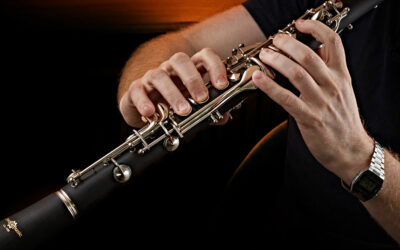



0 Comments